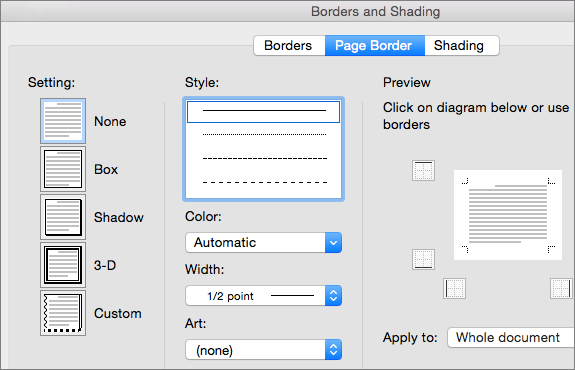Custom Page Number Format In Word For Mac 2016
- Custom Page Number Format In Word For Mac 2016 Pdf
- Custom Page Number Format In Word For Mac 2016 2017
Hi I had a similar problem, and couldn't find a 'borderless option' in the page menu. What worked for me was File-> page setup-> choose 'microsoft word' from top dropdown -> margins -> page setup - paper size -> manage custom paper size -> click '+' to create new custom size -> under non-printable area choose user defined -> set all attributes to '0' -> OK.
Try this -- In a new blank document go to File> Page Setup then in this order. Select the preferred printer from the Format For dropdown; Select the preferred choice from the Paper Size dropdown.
You might still find bottom border missing when you print, but save as 'pdf', this time you it won't through any error. Then print from pdf, you should get the border. Hope it works!!
Hi I had a similar problem, and couldn't find a 'borderless option' in the page menu. What worked for me was File-> page setup-> choose 'microsoft word' from top dropdown -> margins -> page setup - paper size -> manage custom paper size -> click '+' to create new custom size -> under non-printable area choose user defined -> set all attributes to '0' -> OK. You might still find bottom border missing when you print, but save as 'pdf', this time you it won't through any error.
Custom Page Number Format In Word For Mac 2016 Pdf
Then print from pdf, you should get the border. Hope it works!! This was very helpful - Thank you! This was the best and most helpful advice! What worked for me on Mac Word 2011 to save as Adobe Acrobat 2017 PDF was as follows: Open MS Mac 2011 word document.
Custom Page Number Format In Word For Mac 2016 2017
Under MS Word main menu -> File -> Page Setup -> Paper Size -> Manage Custom Sizes -> Non Printable Area (User defined) -> set all to '0' in and save as OK. Save file in Word and then save as PDF and no error messages. Check PDF in Adobe.and Voila! The page numbers show up at the bottom. Thanks for your tip naren543! Apple Footer • This site contains user submitted content, comments and opinions and is for informational purposes only.
Apple may provide or recommend responses as a possible solution based on the information provided; every potential issue may involve several factors not detailed in the conversations captured in an electronic forum and Apple can therefore provide no guarantee as to the efficacy of any proposed solutions on the community forums. Apple disclaims any and all liability for the acts, omissions and conduct of any third parties in connection with or related to your use of the site.

Software for mac free. All postings and use of the content on this site are subject to the.
Thankfully, there’s a much easier way to handle a table of contents if you’re using. Word can not only generate one for you based on styles you’ve applied to your document, it can also update things with the click of a button when your document changes. No more spending your time tracking down and proofreading page numbers! You guys have no idea how happy that makes me, so let’s cover how to create a table of contents in Word 2016 for Mac.
Step 1: Add Styles to Your Document Microsoft Word’s automatic table of contents generator relies on styles, which are special formats you apply to your document so that Word knows which parts of your text are headings, subheadings, paragraphs, and so on. Therefore, the first step to automatically generating a table of contents is to make sure that your document has the appropriate styles applied. To start off, select your first chapter or heading by highlighting it in your document. Next, head up to the Word toolbar (or the “,” as Microsoft so adorably named it) and, from the Home tab, click the Styles button. In the drop-down list that appears, select “Heading 1” to define your selected text as the first primary heading. Note that if your Word window is wide enough, you may see the style options listed directly in the toolbar instead of the “Styles” button. In this case, select the desired heading style directly or click the small downward facing arrow at the bottom of the list to expand all of the styles options.
If your document has sub-headings, select the first one and repeat the steps above, this time choosing “Heading 2.” Repeat these steps as necessary and you’ll end up with something like the screenshot below. Remember, you’re applying these styles to your actual document, not to a manually created table of contents you may already have. In the screenshots, the text is omitted for simplicity. In your actual document, you’ll have paragraphs of text between each Chapter and Subheading. Step 2: Create a Table of Contents Once you’ve added all of your desired headings and subheadings, place your cursor in the location where you’d like your automatically generated table of contents to appear.